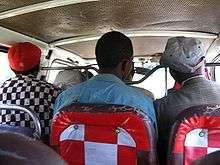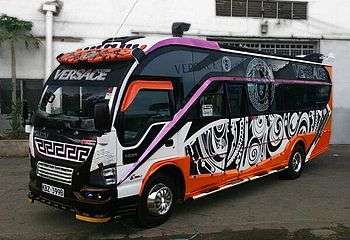Matatu
In Kenya matatu (known as mathree in Sheng) or matatus are privately owned minibuses, although pick-up trucks and estate cars were in the past pressed into service as these Kenyan share taxis.[1] Often decorated, many matatu feature portraits of famous people or slogans and sayings.[2] Likewise, the music they play is also aimed at quickly attracting riders.[3]

Although their origins can be traced back to the 1960s, matatu saw growth in Kenya in the 1980s and 1990s, and by the early 2000s the archetypal form was a (gaily decorated) Japanese microvan.[4] C. 2015, larger, bus-sized vehicles also started to be pressed into service as matatu.
These minibuses ply set routes, run from termini, and are used for both inter- and intra-city travel.[5] In addition to a driver, matatu may be staffed by a conductor,[6] locally known as a makanga or manamba or donda.
As of 1999, they were the only form of public transport available in Nairobi, Kenya, although in 2006 and 2008 this was no longer the case.
Over the years, stiff competition[7] is being experienced from bus-sharing applications such as SWVL.[8]
The name may also be used in parts of Nigeria.[9]
Etymology
The name derives from a Swahili colloquialism meaning "three".[10][11] One explanation is that the wagons originally pressed into service as matatu[12] could be fitted with three rows of bench seats. Other sources maintain that three coins were a typical fare in the 1960s.[10][13]
There is no universally agreed opinion on an origin for the name, however, with a news source indicating its origin lies in the Kikuyu language.[14]
Public perception
At times in Kenya, the matatu has been associated with criminality or reckless driving. Writes one academic, "by the end of the 1990s, matatu operators were typically viewed... by Kenyans of all ranks as thugs who exploited and mistreated passengers and participated in gang or mafia-like violence."[10]
In the early 2000s, struggle over control of matatu routes by informal groups led to violence,[15] and contemporary headlines highlight the fact that matatu were perceived as unsafe. These include a 2002 article titled "riding in Kenya's taxi vans is [a] death-defying experience"[16] and another from 1999 proclaiming that the "menace of deadly matatus [is] to be curbed."[14] Mistreatment of passengers has also been reported and includes: "verbal and physical abuse, theft, hijacking, ...sexual harassment, beatings, and rape."[17]
Kenyan regulation

Explicitly deemed legal in 1973, it wasn't until 1984 that even the most basic regulatory framework was constructed for matatu, when licensing and inspections were mandated.[4]
Today, the Kenyan regime has been described as having extensive regulatory controls, and in this country a matatu worker can be pulled from the streets simply for sporting too loud a shirt.[18] Some basic safety equipment is required; these minibuses must be fitted with seatbelts and speed governors.[19] It's unclear, however, to what extent such laws are followed.
Present regulation may not be a sufficient deterrent to prevent small infractions as even decoration may be prohibited.[20] Laws prohibiting flashy paint-jobs and eye-searing colors were removed in 2015, and as of 2016 matatu in Kenya are brightly decorated with some operators paying upwards of US$2,000 for custom, decorative paint.[21]
In the 1990s and 2000s, informal groups emerged managing routes and requiring matatu drivers to pay fees.[15] At times, competition over control of routes precipitated violence.[15] Today, an individual matatu must be associated with one of over 600 independent, government-registered groups known as a SACCOs.[22]
As of late 2010, Kenyan government policy is to phase out minibus matatu in the capital city Nairobi in favour of larger buses seating twenty five or more. Currently no new matatu vehicles can operate in Nairobi, while the existing ones will be allowed to continue serving passengers until they become completely inoperable. It could take ten years or more to ease the congestion caused by more-popular smaller minibuses, however.[23]
Popular media
In the Netflix series Sense8, Capheus, who lives in Nairobi and is one of the main characters, drives the matatu Van Damn, a tribute to Capheus' favorite action star, Jean-Claude Van Damme.
See also
References
- For Kenya and neighbouring nations, see Kenya's Taxi Vans Are Packed and Perilous nytimes.com, 24 April 1988
- For private ownership, see In Nairobi, Kenya puts brakes on its runaway success csmonitor.com, 28 June 1999
- For matatu as minibuses, see Kenya (page 383) Tom Parkinson, Max Phillips, Will Gourlay. Lonely Planet, 2006. 416 pages. 1740597435, 9781740597432.
- For past use of pick-up trucks, see Have You Ever Taken A Matatu? Archived 25 June 2011 at the Wayback Machine glpinc.org. and "Field notes: a matatu, a bike and a walk" Schatz, Enid. Contexts Vol. 2, No. 3 (SUMMER 2003), pp. 58-59
- For past use of estate cars, see Muyia, Nafukho. "The Forgonen Workers" (PDF). Social Science Research Report Series, no. 18. Organization for Social Science Research in Eastern and Southern Africa. p. 7. Retrieved 25 September 2012.
- For portraits, see Nairobi Today: the Paradox of a Fragmented City; Hidden $ Centz: Rolling the Wheels of Nairobi Matatu. Mbugua wa-Mungai. (page 376) edited by Helene Charton-Bigot, Deyssi Rodriguez-Torres. African Books Collective, 2010. 404 pages. 9987080936, 9789987080939.
- For slogans and sayings, see Roll over Snoop Dogg, Ocampo is new king of the matatu csmonitor.com, 29 January 2010
- DJ Edu (21 February 2015). "The buses you choose because of their music". Radio 1Xtra. BBC. Retrieved 1 March 2015.
- Mutongi, Kenda (2017). Matatu: A History of Popular Transportation in Nairobi. University of Chicago Press. pp. 7–8. ISBN 022647142X.
- For set routes, see Kenya (page 382) Tom Parkinson, Max Phillips, Will Gourlay. Lonely Planet, 2006. 352 pages. 1740597435, 9781740597432.
- For termini, see Nairobi Today: the Paradox of a Fragmented City; Hidden $ Centz: Rolling the Wheels of Nairobi Matatu. Mbugua wa-Mungai. (page 374) edited by Helene Charton-Bigot, Deyssi Rodriguez-Torres. African Books Collective, 2010. 404 pages. 9987080936, 9789987080939.
- For intra and inter-city travel, see Negotiating social space: East African microenterprises (page 69) Patrick O. Alila, Poul O. Pedersen. Africa World Press, 2001. 353 pages. 0865439648, 9780865439641.
- Nairobi Today: the Paradox of a Fragmented City; Hidden $ Centz: Rolling the Wheels of Nairobi Matatu. Mbugua wa-Mungai. (page 371) edited by Helene Charton-Bigot, Deyssi Rodriguez-Torres. African Books Collective, 2010. 404 pages. 9987080936, 9789987080939.
- Ride sharing applications disrupt matatu industry in Kenya, see
- SWVL site
- "The Boda-Boda Boom - Part Two". The Boda Boda Boom. 1 March 2016. 6 or 7 minutes in. BBC.
- Thugs or Entrepreneurs? Perceptions of matatu Operators in Nairobi, 1970 to the Present. Kenda Mutongi. Africa: Journal of the International African Institute Vol. 76, No. 4 (2006), pp. 550
- Edward Harris. "Matatu buses add color, entertainment to Kenya's rutted roads." Sunday Gazette-Mail. Gazette Daily Inc. 2007. HighBeam Research. 13 June 2015
- Muyia, Nafukho. "The Forgonen Workers" (PDF). Social Science Research Report Series, no. 18. Organization for Social Science Research in Eastern and Southern Africa. p. 7. Retrieved 25 September 2012.
- McKinley Jr., James C. (16 April 1996). "Nairobi Journal;Take (On) the Minibuses, if You Dare". The New York TImes. Retrieved 7 June 2015.
- Otani, Robert. "Menace of Deadly Matatus to Be Curbed." African Business. IC Publications Ltd. 1999. HighBeam Research. 6 June 2015
- A City under Siege: Banditry & Modes of Accumulation in Nairobi, 1991-2004. Musambayi Katumanga. Review of African Political Economy Vol. 32, No. 106, Africa from SAPs to PRSP: Plus Ca Change Plus C'est la Meme Chose (Dec., 2005), pp. 505-520
- "Riding in Kenya's taxi vans is death-defying experience." Chicago Tribune (Chicago, IL). Tribune. 2002. HighBeam Research. 6 June 2015
- "No Mercy, No Remorse": Personal Experience Narratives about Public Passenger Transportation in Nairobi, Kenya. Mbugua wa Mungai and David A. Samper. Africa Today. Vol. 52, No. 3 (Spring, 2006), pp. 51-81
- For extensive Kenyan regulatory control, see Stuck in Traffic; Urban Transport in Africa (page 14) Ajay Kumar & Fanny Barrett. Africa Infrastructure Country Diagnostic in co-operation with the World Bank, January 2008. Draft Final Report.
- For loud shirts as illegal, see Nairobi Today: the Paradox of a Fragmented City; Hidden $ Centz: Rolling the Wheels of Nairobi Matatu. Mbugua wa-Mungai. (page 376) edited by Helene Charton-Bigot, Deyssi Rodriguez-Torres. African Books Collective, 2010. 404 pages. 9987080936, 9789987080939.
- Kenya (page 383) Tom Parkinson, Max Phillips, Will Gourlay. Lonely Planet, 2006. 352 pages. 1740597435, 9781740597432.
- For regulation as insufficient deterrent, see Nairobi Today: the Paradox of a Fragmented City; Hidden $ Centz: Rolling the Wheels of Nairobi Matatu. Mbugua wa-Mungai. (page 367) edited by Helene Charton-Bigot, Deyssi Rodriguez-Torres. African Books Collective, 2010. 404 pages. 9987080936, 9789987080939.
- For decoration being prohibited, see Nairobi Today: the Paradox of a Fragmented City; Hidden $ Centz: Rolling the Wheels of Nairobi Matatu. Mbugua wa-Mungai. (page 371) edited by Helene Charton-Bigot, Deyssi Rodriguez-Torres. African Books Collective, 2010. 404 pages. 9987080936, 9789987080939.
- "Inside Africa" CNN International 25 October 2016
- For requirement to associate, see "Kamwaro on Matatu Sacco". Standard Digital. 16 February 2011. Retrieved 14 June 2015.
- For number of SACCOs and government registration, see "REGISTERED SACCOS AND COMPANIES" (PDF). National Transport and Safety Authority. Government of Kenya. 13 January 2015. Retrieved 14 June 2015.
- Ngirachu, John (31 December 2010). "New rules to rein in wild sector". Daily Nation. Nation Media Group. Retrieved 8 April 2016.
External links
- "Ma3, a band inspired by matatu". Network Africa. BBC World Service. 27 February 2012.